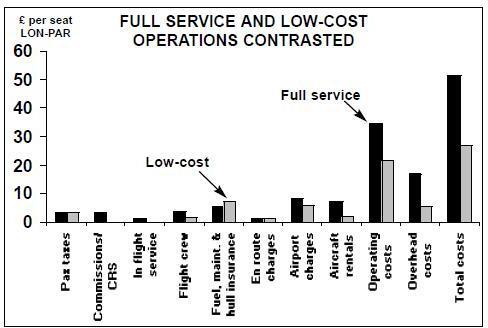What's the cost difference?
December 1997


The cost advantage a low–cost carrier has over its full service competitor is about £25 per one–way seat on a route like London–Paris — £27 against £52. That, at least, is our estimate, based on a comparison of a Euro–major operating a new–ish 737–400 Heathrow -Orly and a putative newcomer operating an elderly 737–200 Stansted–Beauvais, with the same aircraft utilisation rate and the same load factor (68%). Bear in mind the usual caveats about data, generalisations, assumptions, etc.
- Passengers taxes UK passenger taxes are now up to £10 a head and also have to be included in the advertised price. As this is a flat rate tax both carriers pay the same price per passenger (or more correctly both act as unpaid tax collectors), but the low–cost operator suffers because of the disproportionate impact of the tax on the bargain fare.
- Commission and CRS Assuming the high–cost airline sells 80% of its tickets and the low–cost relies solely on direct sales, the cost difference is about £3.50/seat.
- In flight service A meal and booze averages perhaps £2 a passenger on the full service aircraft, zero on the low cost airline — an advantage of £1.30 a seat.
- Cockpit and crew cost The difference of £2.50 a seat is surprisingly modest because flight crew costs make up a relatively small proportion of total operating costs on such short sectors.
Nevertheless, the average difference in salaries and social costs between flying crew on the two airlines is 60%. However, the difference between the average low–cost salary and the salary of an employee at the bottom of the seniority scale at a high–cost carrier is not significant, which is why the low–cost airlines are able to compete for crews even in a tight labour market.
- Fuel, maintenance and hull insurance Here there is a £1.50 advantage per seat to the high–cost carrier because of greater fuel efficiency, lower maintenance charges, etc.
- En route charges Eurocontrol does not discriminate between carrier types so there is no difference in costs between the two airlines.
- Airport charges The £2.50 difference between congested Heathrow and uncongested Stansted is possibly an underestimate as low–cost carriers have typically negotiated sweetheart deals with the airport authorities (though these are now beginning to expire).
- Aircraft rentals This may not be a cash cost but it does represent the biggest operating cost difference between the two carriers — £4.80 per seat. To facilitate the comparison we have calculated this equipment cost element on the assumption that the modern 737–400 and the elderly 737–200 are both on operating leases. Access to low cost aircraft has been a prerequisite for setting up a low–cost airline, but this cost advantage starts to be lost when the carrier decides to expand by investing in expensive new aircraft.
So total variable operating costs add up to £35 for high–cost and £22 for low–cost, a difference of 38%.
- Overhead costs Station costs, passenger services, administration, finance department, CEO’s office, etc. represent the mature airline’s burden. They are impossible to pin down but we have made an heroic guess — £17 on a per seat basis for the high–cost (based on an allocation of a proportion of total BA overheads to the Europe region) and £5.50 for the low–cost (based on Ryanair’s total overhead burden). Overheads largely reflect differences in personnel costs and location costs.
Finally then, we arrive at £52 and £27 per seat, a difference of 49%, somewhat less than the difference between BA’s lowest unrestricted economy fare — £120 (excluding tax) — and what one would expect to be the low–cost standard fare — £40.
